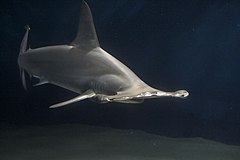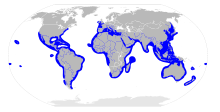Hammerhead shark
| Hammerhead sharks Temporal range: Middle Miocene to Present |
|
|---|---|
 |
|
| Scalloped hammerhead, Sphyrna lewini | |
| Scientific classification | |
| Kingdom: | Animalia |
| Phylum: | Chordata |
| Class: | Chondrichthyes |
| Subclass: | Elasmobranchii |
| Superorder: | Selachimorpha |
| Order: | Carcharhiniformes |
| Family: |
Sphyrnidae T. N. Gill, 1872 |
| Genera | |
 |
|
The hammerhead sharks are a group of sharks in the family Sphyrnidae, so named for the unusual and distinctive structure of their heads, which are flattened and laterally extended into a "hammer" shape called a cephalofoil. Most hammerhead species are placed in the genus Sphyrna while the winghead shark is placed in its own genus, Eusphyra. Many not necessarily mutually exclusive functions have been proposed for the cephalofoil, including sensory reception, manoeuvering, and prey manipulation. Hammerheads are found worldwide in warmer waters along coastlines and continental shelves. Unlike most sharks, hammerheads usually swim in schools during the day, becoming solitary hunters at night. Some of these schools can be found near Malpelo Island in Colombia, Cocos Island off Costa Rica, and near Molokai in Hawaii. Large schools are also seen in the waters off southern and eastern Africa.
The known species range from 0.9 to 6 m (3.0 to 19.7 ft) in length and weigh from 3 to 580 kg (6.6 to 1,278.7 lb). They are usually light gray and have a greenish tint. Their bellies are white which allows them to blend into the ocean when viewed from the bottom and sneak up on their prey. Their heads have lateral projections which give them a hammer-like shape.
Hammerheads have disproportionately small mouths and seem to do a lot of bottom-hunting. They are also known to form schools during the day, sometimes in groups of over 100. In the evening, like other sharks, they become solitary hunters. National Geographic explains that hammerheads can be found in warm tropical waters, but during the summer Hammerheads participate in a mass migration to search for cooler waters.
Since sharks do not have mineralized bones and rarely fossilize, it is their teeth alone that are commonly found as fossils. The hammerheads seem closely related to the carcharhinid sharks that evolved during the mid-Tertiary Period. According to DNA studies, the ancestor of the hammerheads probably lived in the Miocene epoch about 20 million years ago.
...
Wikipedia
